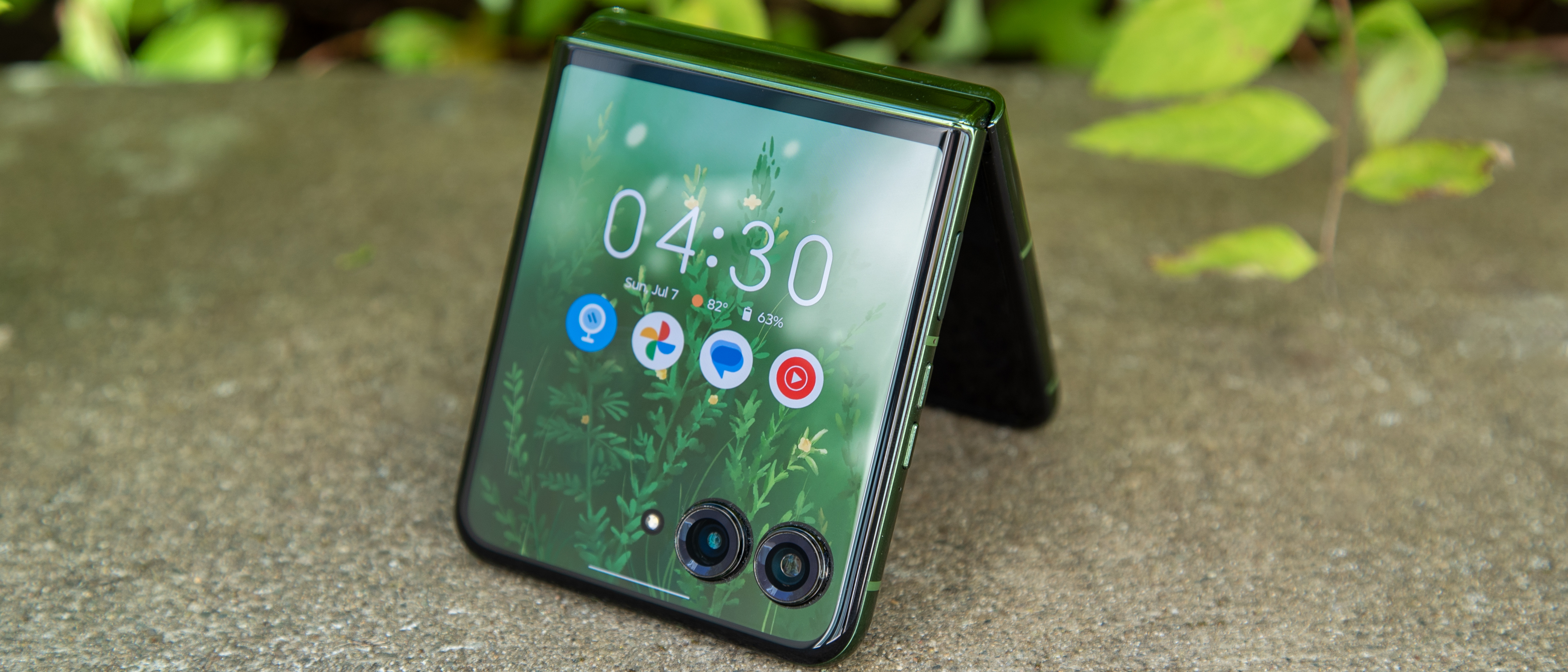Android Central Verdict
The Motorola Razr Plus 2024 is an impressive phone that continues to set the standard for other flip phones. The 4-inch cover screen is more useful than ever, and Motorola has clearly put more thought into the software around it. Cameras and battery life are also much improved, but there are some blips when it comes to the overall software experience, and some may not like the switch from ultrawide to telephoto. But overall, the Razr Plus 2024 is a great phone that you should consider as your next.
Pros
- +
Great design with faux leather on all colors
- +
Snapdragon chip performs well
- +
Displays are bright, sharp, and fluid
- +
Large cover screen can do even more
- +
Primary camera quality is quite acceptable
- +
New Hello UI gives Motorola more individuality
Cons
- -
There's some weird software jank
- -
Some might not like the switch from ultrawide to telephoto
- -
More interesting Moto AI features not available at launch
- -
Cover screen still feels overpowered
Why you can trust Android Central
Let me just start off by saying this: the Motorola Razr Plus 2024 is my new favorite phone. That may not be too surprising since I spent so much time over the past year gushing over the Razr Plus 2023, but there were some pretty glaring issues with last year's model that I was willing to ignore because I enjoyed the overall experience. This year, that's no longer the case.
Motorola seemed to address just about everything that I didn't like about last year's Razr Plus while adding some upgrades I didn't expect. The result is a phone that is exactly what I wish we got last year and what I believe sets a new standard for flip phones.
Of course, no phone is perfect, and the Razr Plus 2024 has its quirks. But Samsung should really be taking notes for the Galaxy Z Flip lineup because Motorola is really doing something special with its 2024 Razr lineup.
Motorola Razr Plus 2024: Price & availability

The Motorola Razr Plus 2024 was announced on June 25, 2024. The phone is available for preorder starting July 10, retailing for $999, and it will go on sale starting July 24, where it can be purchased unlocked at Motorola.com, Best Buy, and Amazon. It will also be available at T-Mobile, Consumer Cellular, and Xfinity Mobile.
On July 25, the phone will be available at the following carriers: Cricket, Spectrum Mobile, Straight Talk, Total by Verizon, Visible, Google Fi Wireless, Optimum Mobile, and UScellular. Boost Mobile customers will be able to purchase the phone later this summer.
The Razr Plus 2024 is available in one configuration and offered in four color options: Midnight Blue, Spring Green, Peach Fuzz, and Hot Pink. Color options will vary depending on the carrier.
Motorola Razr Plus 2024: Design & display
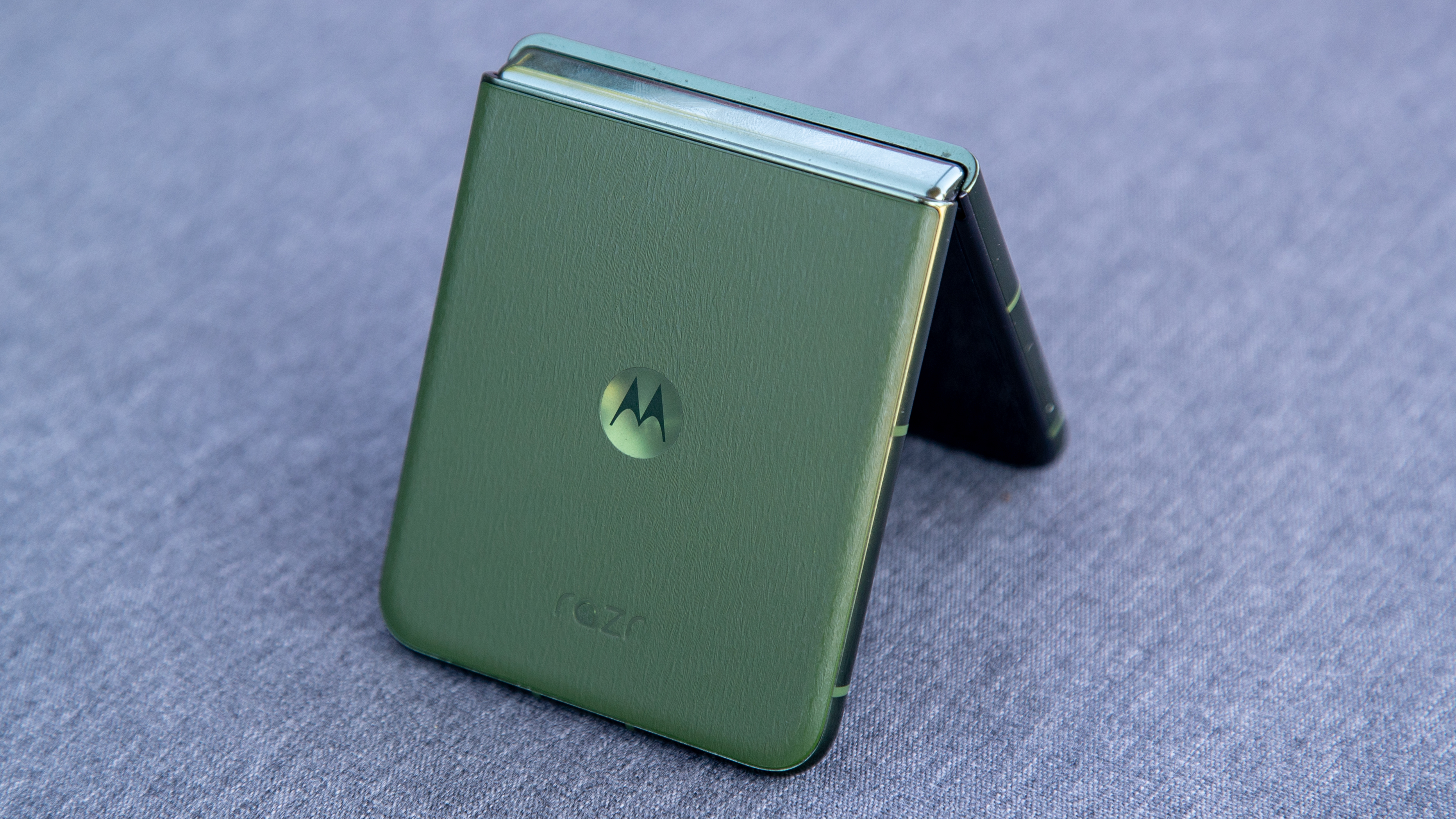
If you're familiar with the Motorola Razr Plus 2023, then the 2024 should look quite familiar. The design is largely the same, which is to be expected with a yearly upgrade, but there are some notable changes worth pointing out. On the front, the biggest difference is the larger cover screen, which takes up the entire front panel and rids the aluminum bar that connects to the frame. This means the only hints of color you get when looking at the phone straight on are the hinge and a bit of the frame.
Talking about the frame, it retains its glossy, rounded design, seamlessly blending into the front and back panels. However, this year, Motorola went with faux vegan leather for all colors, meaning you'll only find glass on the front. I really like this, as it means there's less worry when dropping the phone, although I'd still recommend a case, especially a screen protector for the cover display.
I have the Spring Green colorway, but the phone also comes in Midnight Blue, Hot Pink, and Peach Fuzz. What I like about the green color option is that not only does it look good, but the material feels quite different from the other colors. It almost resembles grass in both look and feel, which makes sense given the name of the color. I honestly find this to be quite a nice touch.

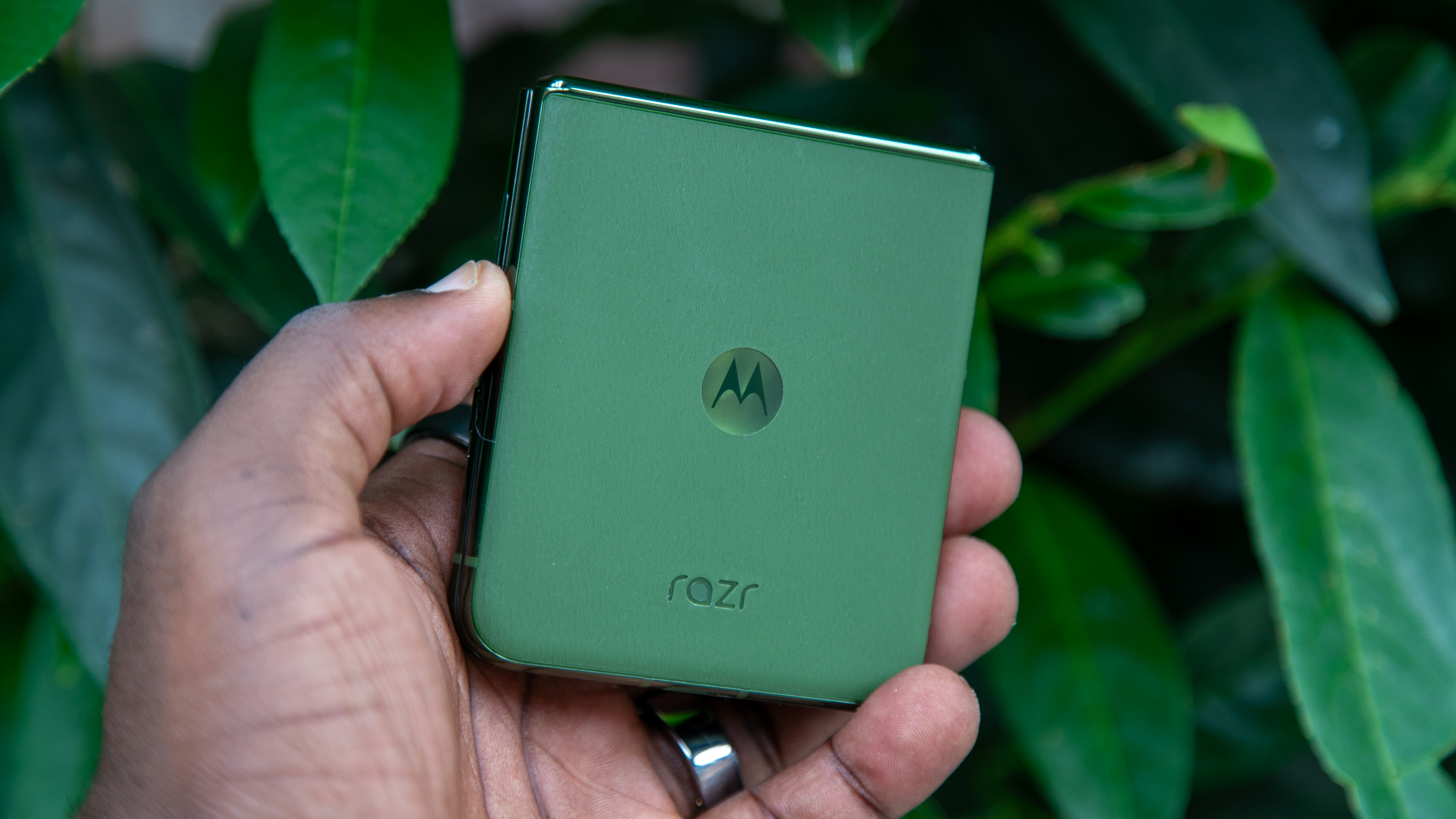
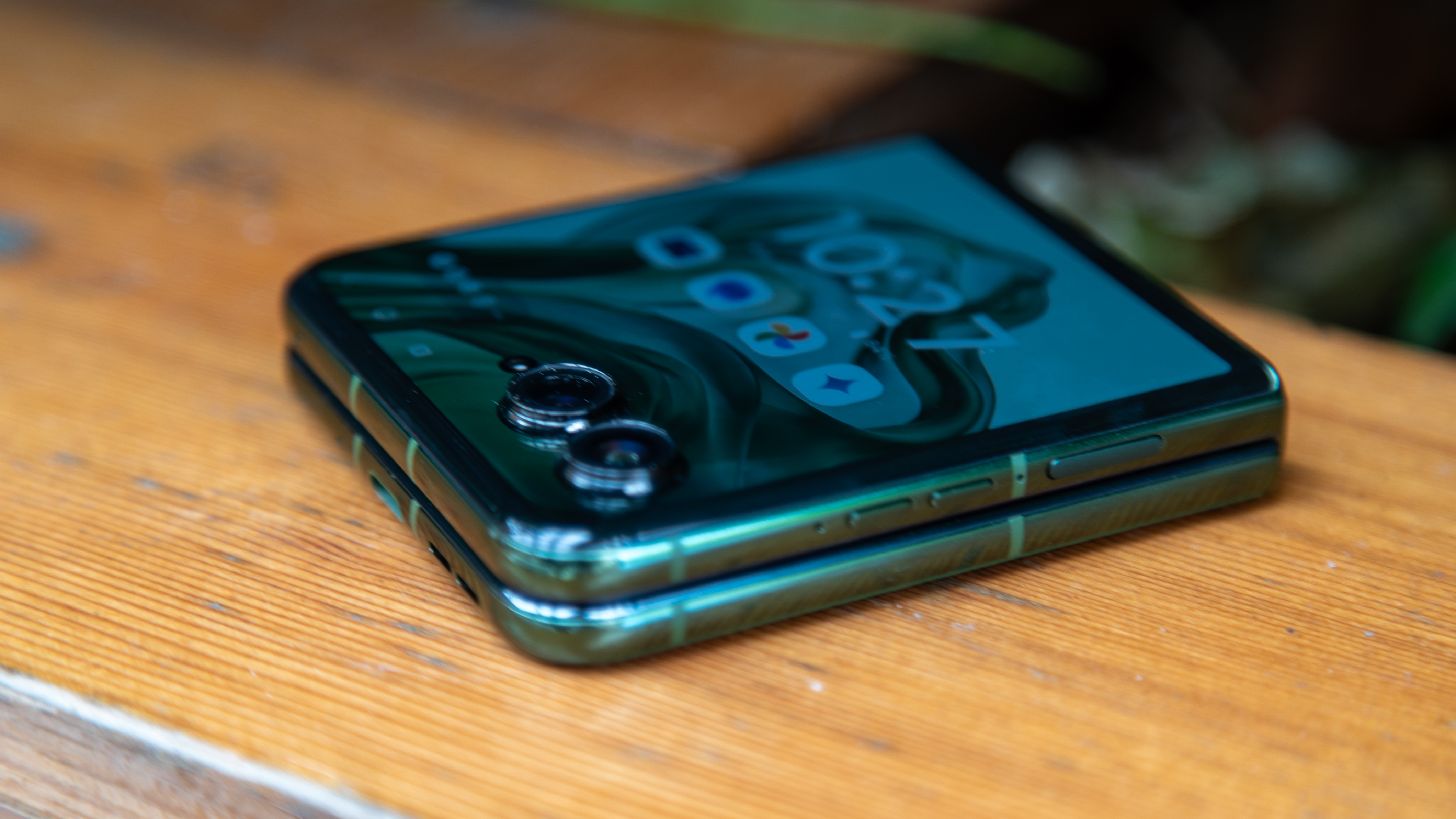
Motorola seems to have improved the hinge this year. It's smaller when compared to the Razr Plus 2023, but it feels much sturdier when compared to last year's fairly wobbly hinge. With the Razr Plus 2024, opening the phone also feels much more satisfying and intentional, and closing it produces a much hardier sound. The hinge isn't as stiff as that of the Galaxy Z Flip 5, which I kind of prefer, as Samsung's phone often takes a bit more effort to open.
Motorola also tweaked the water resistance on the Razr Plus 2024, giving it an IPX8 rating. This means you can submerge the phone completely, and it should survive, at least up to a point. Living in Seattle, where it's often wet and there are lakes everywhere, this is a great addition. It does come at the expense of dustproofing, but Motorola says this level of water resistance inherently includes protection against dust.
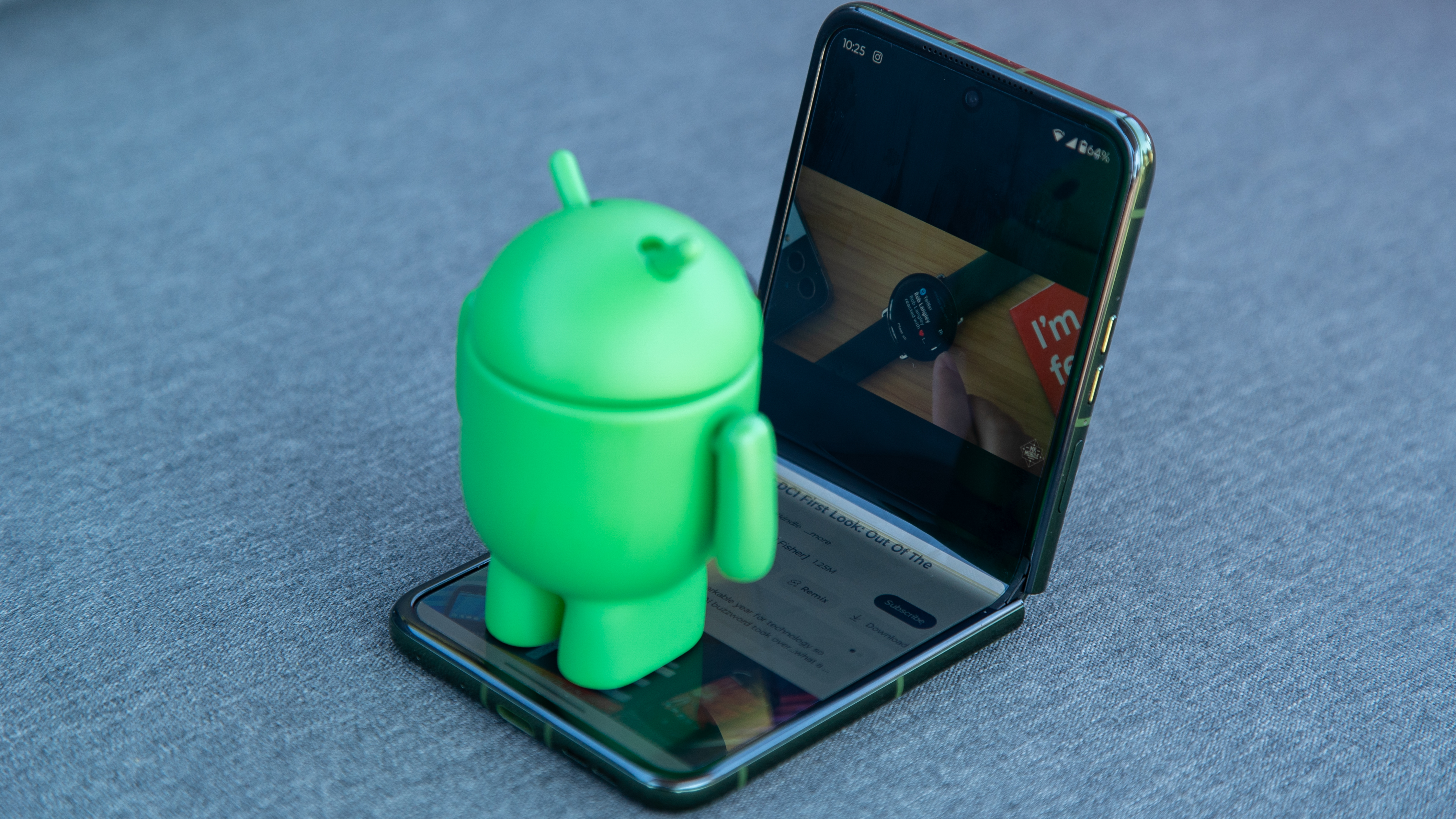
The internal display is the same 6.9-inch OLED panel, but there have been some improvements made. The crease looks and feels even less noticeable than on the Razr Plus 2023, which is saying something. The built-in screen protector also now covers more of the display, including the front-facing camera, resulting in a much more seamless-looking display.
The improvements continue once you turn the display on. Still the same 165Hz refresh rate as before, but Motorola increased the brightness by quite a bit, reaching a peak of 3000 nits. The color reproduction also appears to be much better, and the phone now gives you three display options, so you can choose between Natural, the newly added Radiant, and Vivid. I tend to keep phones on Natural because Vivid is often too... vivid. However, Radiant is a nice addition as it's a good medium between the two, so I keep the Razr Plus 2024 on this setting.
Motorola also includes flicker protection, which you might appreciate if you suffer from PWM sensitivity. I do miss the peek display feature found on previous Motorola phones, which was a clever way to utilize the AOD, but there are other sleep options that kind of make up for it, which I'll talk about later.
Motorola Razr Plus 2024: Specs & performance
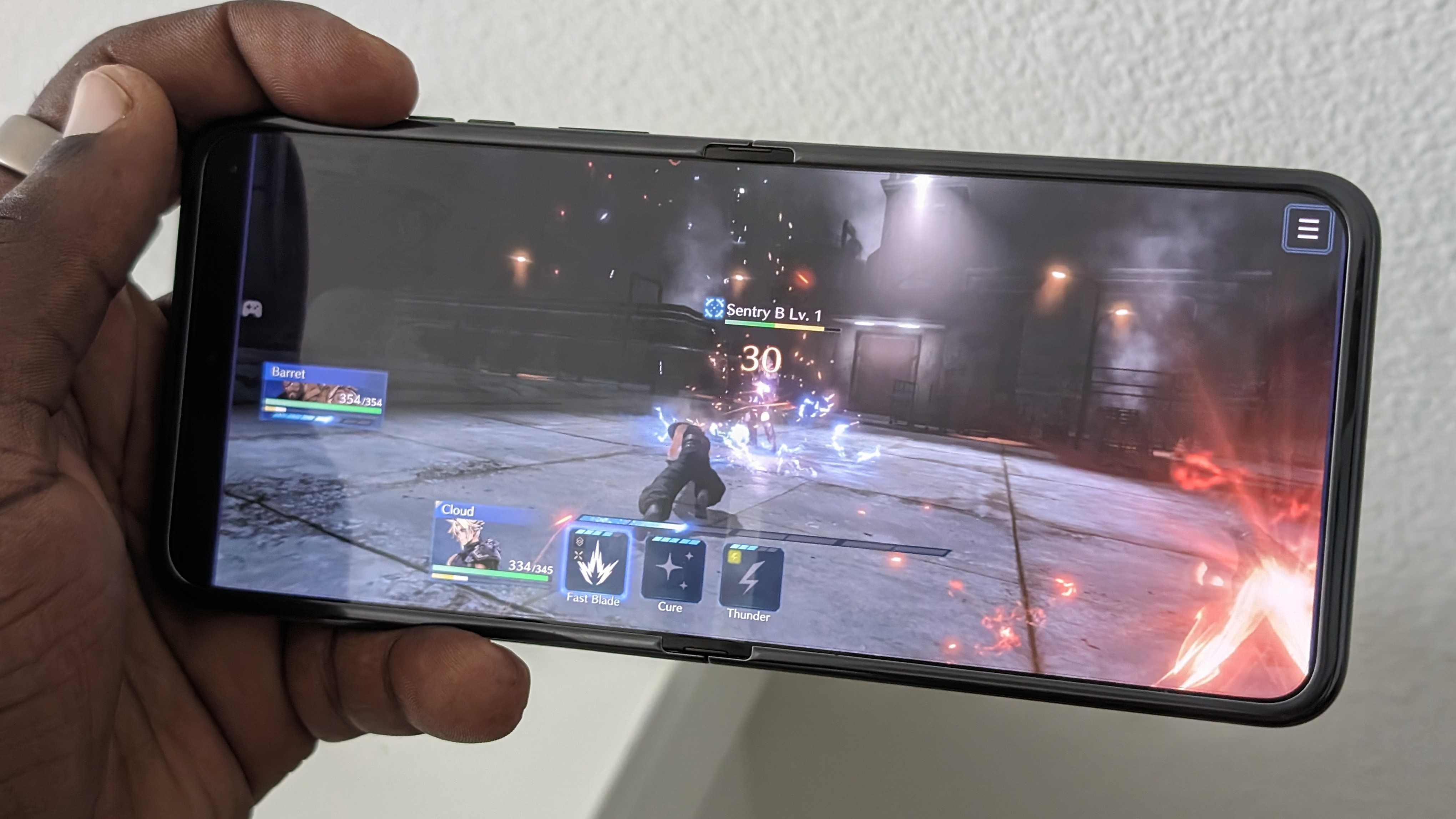
Last year's model was a bit behind with its chipset, using a slightly older Snapdragon 8 Plus Gen 1. This year, Motorola is using an up-to-date flagship chip with the Snapdragon 8s Gen 3, although it's still a slight downgrade compared to the premium Snapdragon 8 Gen 3. You wouldn't really know it in regular use, however, as the phone performs spectacularly. Apps open quickly, I don't notice the usual lag when recording video, and the phone seems to be able to handle background apps much better, likely thanks to the 12GB of RAM.
Games like Honkai: Star Rail and Final Fantasy VII Ever Crisis default to high or ultra settings, and they load fast with virtually no gameplay issues. Honkai can even handle the highest settings at 60fps, and gameplay is smooth.
| Category | Motorola Razr Plus 2024 |
|---|---|
| OS | Android 14 (Hello UX) |
| Display (internal) | 6.9-inch, pOLED, FHD+ (2640 x 1080), 165Hz LTPO, 3000 nit peak, 22:9 |
| Display (external) | 4-inch, pOLED, 1272 x 1080, 165Hz, LTPO 2400 nit peak |
| Chipset | Snapdragon 8s Gen 3 |
| RAM | 12GB LPDDR5x |
| Storage | 256GB, UFS 4.0 |
| Rear Camera 1 | 50MP wide, f/1.7, 0.8μm (1.6μm w/ pixel binning), OIS |
| Rear Camera 2 | 50MP 2x telephoto, f/2.0, 0.64μm (1.28μm w/ pixel binning) |
| Selfie Camera | 32MP, f/2.4, 0.7 μm (1.4μm w/ pixel binning) |
| Audio | 3 mics, stereo speakers, Dolby Atmos, Spatial Sound, Snapdragon Sound 4 |
| Connectivity | 5G, Wi-Fi 7, Bluetooth 5.4, NFC |
| Security | Fingerprint sensor, Face unlock |
| Protection | IPX8, Gorilla Glass Victus |
| Battery | 4000mAh, 45W wired charging, 15W wireless, 5W reverse-wireless |
| Dimensions (open) | 73.99 x 171.42 x 7.09mm |
| Dimensions (closed) | 73.99 x 88.09x 15.32mm |
| Weight | 189 |
| Colors | Midnight Blue, Spring Green, Peach Fuzz, Hot Pink |
The audio situation isn't bad, but it could be better. The phone features dual stereo speakers with Dolby Atmos and support for spatial sound. The speakers sound fine, although they're a bit hollow when playing music. I'm no audiophile, but the audio isn't as good as the Pixel 8 Pro, which sounds very deep.
You also won't be blown away by the phone's haptics, but I'm happy to say they're at least much better than Motorola's lower-end phones.
You'll find Bluetooth 5.4, NFC, and sub-6 5G. There's no mmWave (sorry, Verizon subscribers), which is likely so Motorola can keep costs down. There's also no UWB, which is an odd choice given the simultaneous launch of the Moto Tag, which utilizes the tech to locate your items with phones that support it.
Motorola Razr Plus 2024: Cover screen

My favorite thing about the Motorola Razr Plus 2024 is the cover screen, and it's how I interact with the phone most of the time. It's now a larger 4-inch OLED panel with a high pixel density and 165Hz refresh rate. Is that overkill? Perhaps. My main complaint last year was that 144Hz on a 3.6-inch OLED wasn't doing much to help the abysmal battery life situation. That said, Motorola opted for an LTPO panel on the Razr Plus 2024, which means the display will dynamically adjust the refresh rate based on what's being displayed.
This should help improve the battery consumption from the cover screen, although I would like it if Motorola would let me adjust the cover screen refresh rate on its own from the main display. Still, the display is a massive improvement over the Razr Plus 2023, with a peak brightness of 2400 nits, so it's much more visible outside.

Motorola also tweaked the software on the cover screen, so it's much more useful. For instance, you can now set app shortcuts on the home screen. There's also a new widget panel to put your favorite widgets in one space.
Meanwhile, other panels have been revamped with better visuals, and there are even new animations. Motorola even added a new pinching gesture that lets you see all your panels at once, something that was shamelessly borrowed from Samsung.
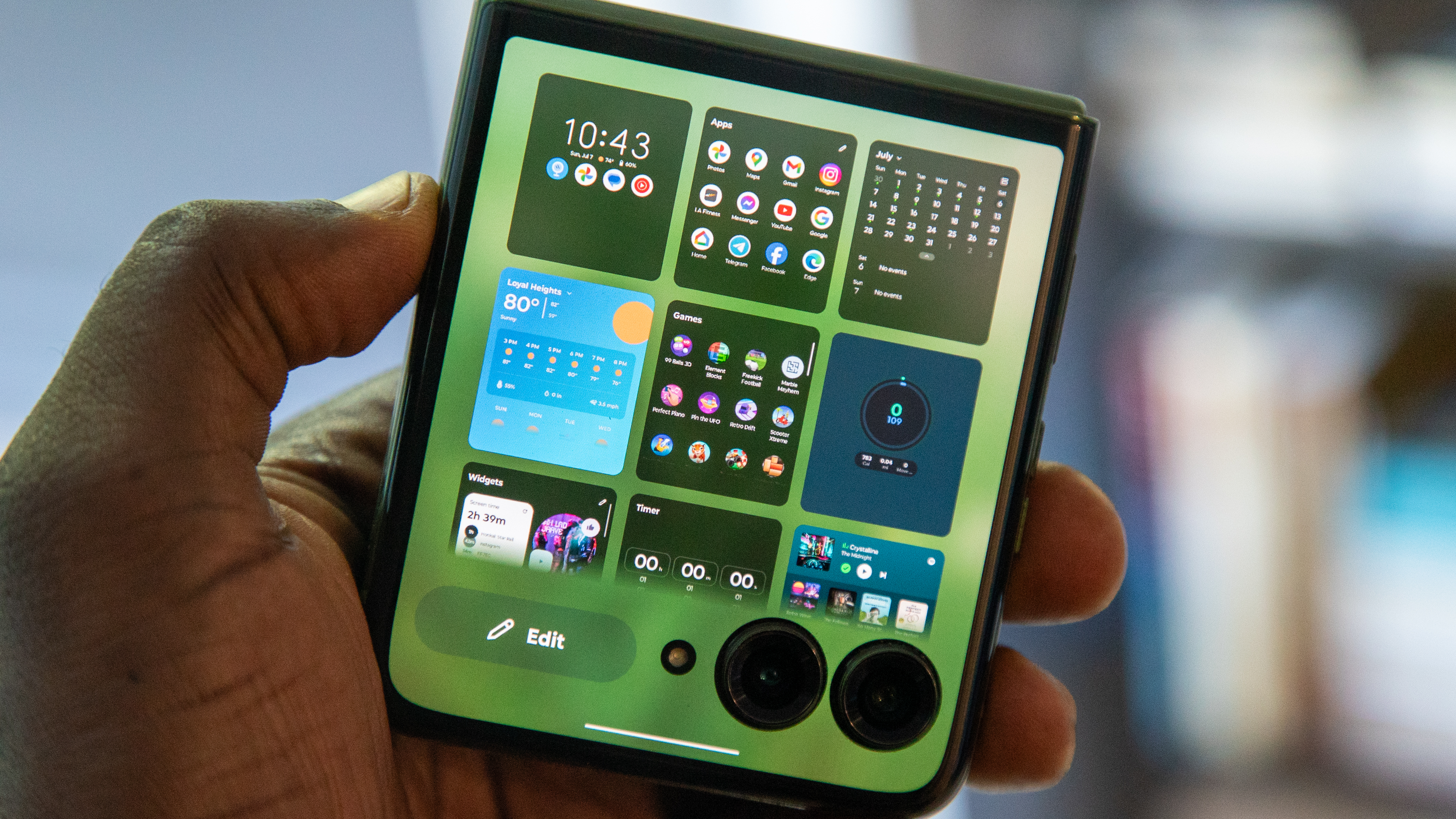

Regardless, the new UI looks and feels a lot better and much more thought out. Little quality-of-life updates add to the experience, like now being able to enter a full-screen text mode when typing so that you can actually see what you're typing, something that was often an issue with the previous Razr Plus. Google services like Google Messages can now be viewed in full screen, and you now have access to the Google Photos app and Gemini from the cover screen. There are also new music player skins, which I think is a very nice touch.
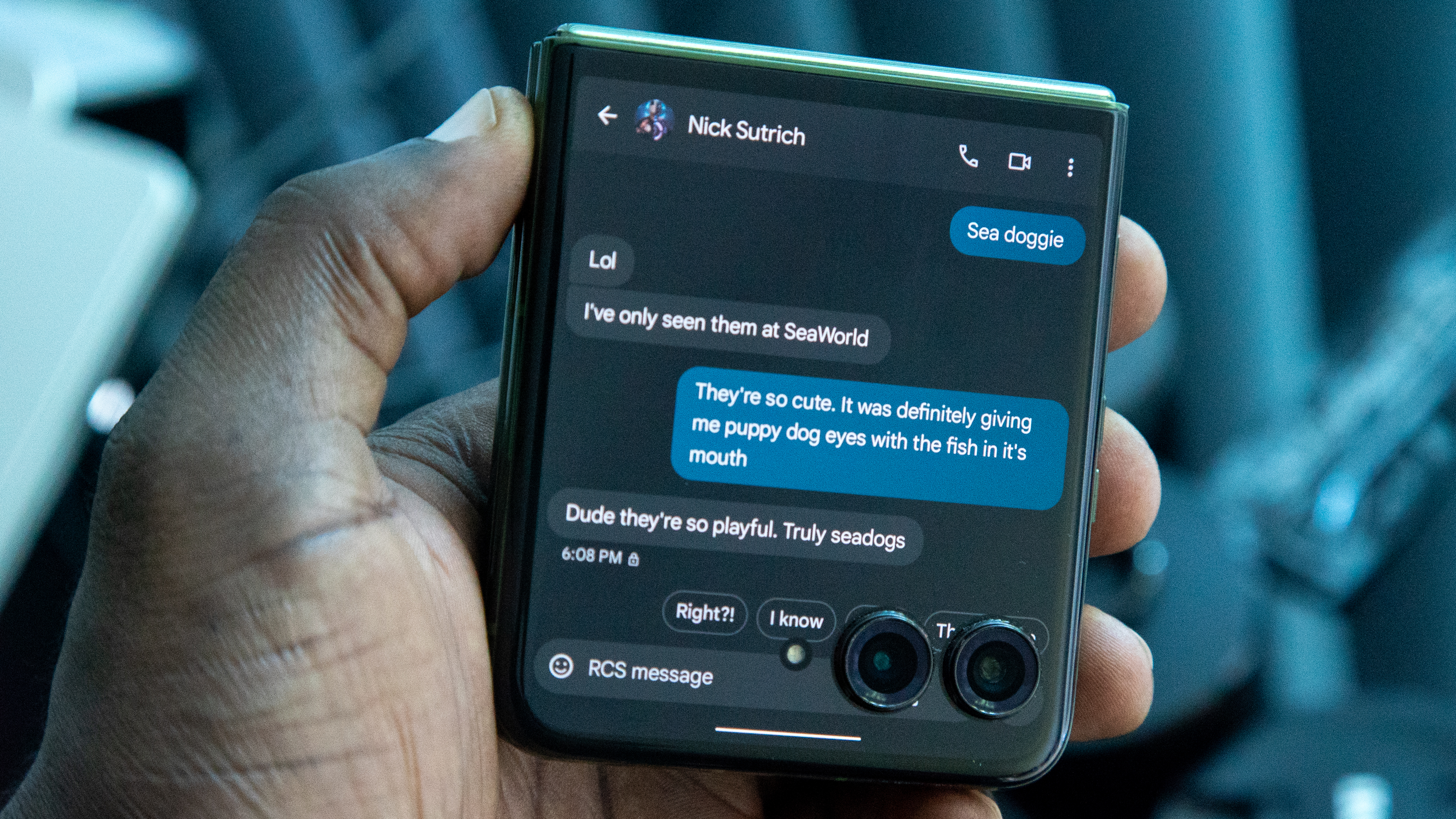

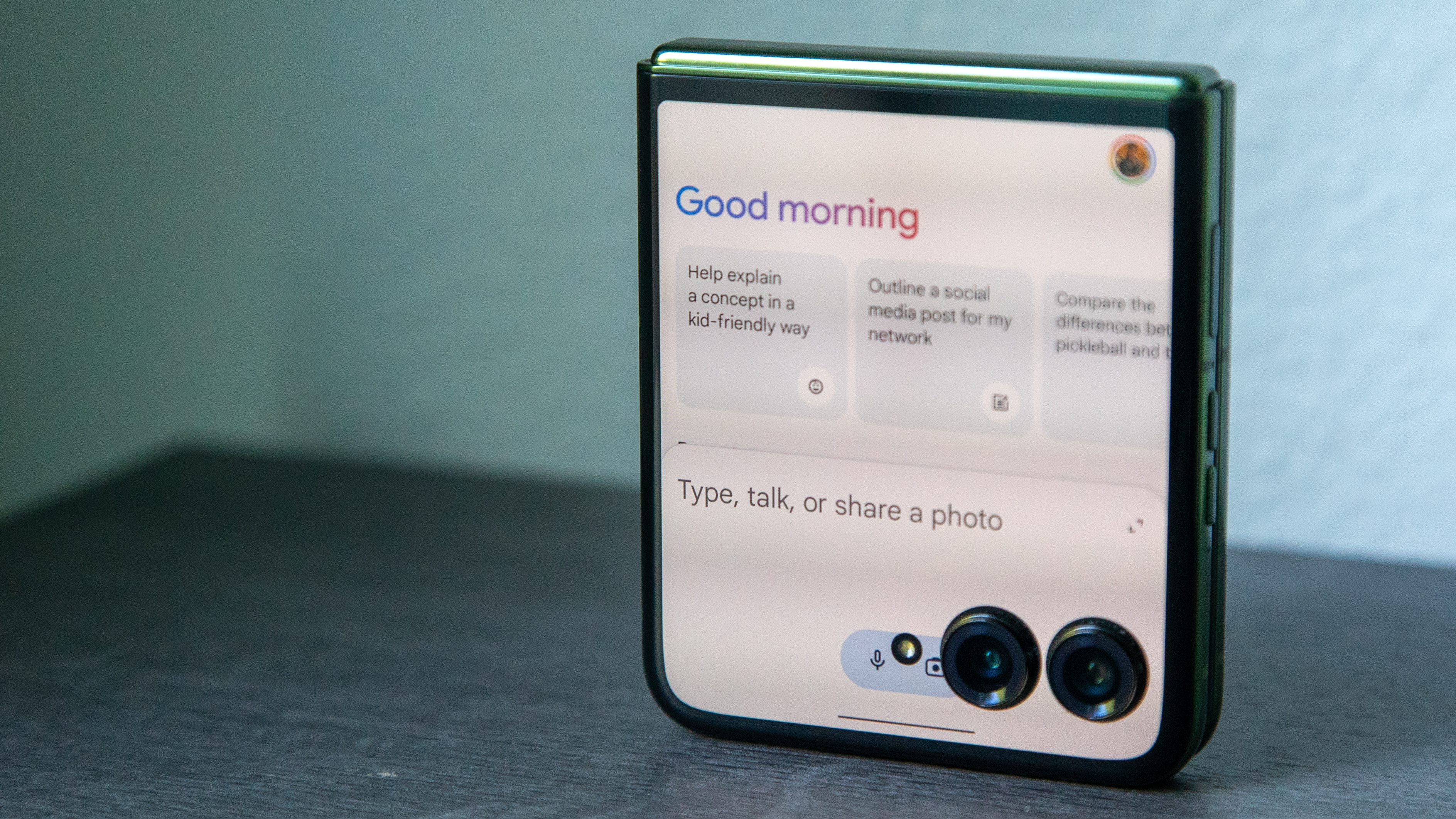
I will say that setting up the cover screen can be a bit of a hassle because it feels like you have to set up the Razr Plus 2024 twice. You select which panels you want, which apps you want to access from the Apps panel, and which contacts you want to add... it's a lot. But once it's all set up, using the cover screen is quite fun and fairly easy to get the hang of, especially when transitioning apps from the main screen to the cover screen and vice versa.
The added screen real estate gives apps more space to shine, although vertical videos will still often be cropped down, meaning you'll have to open the phone to get the full picture. I also find that some apps like Instagram won't hold your place in the feed when you move from the cover screen to the main display, which can be annoying.
When you're not using the phone, Motorola has added two new idle modes: Sleep display and Desk display. The Sleep display is where you'll find the new AOD, which lets you view the time, notifications, and other info while the phone is locked. You can also wake the display just by bringing your hand up to the cover screen without touching it, or you can nudge the phone to wake it up.
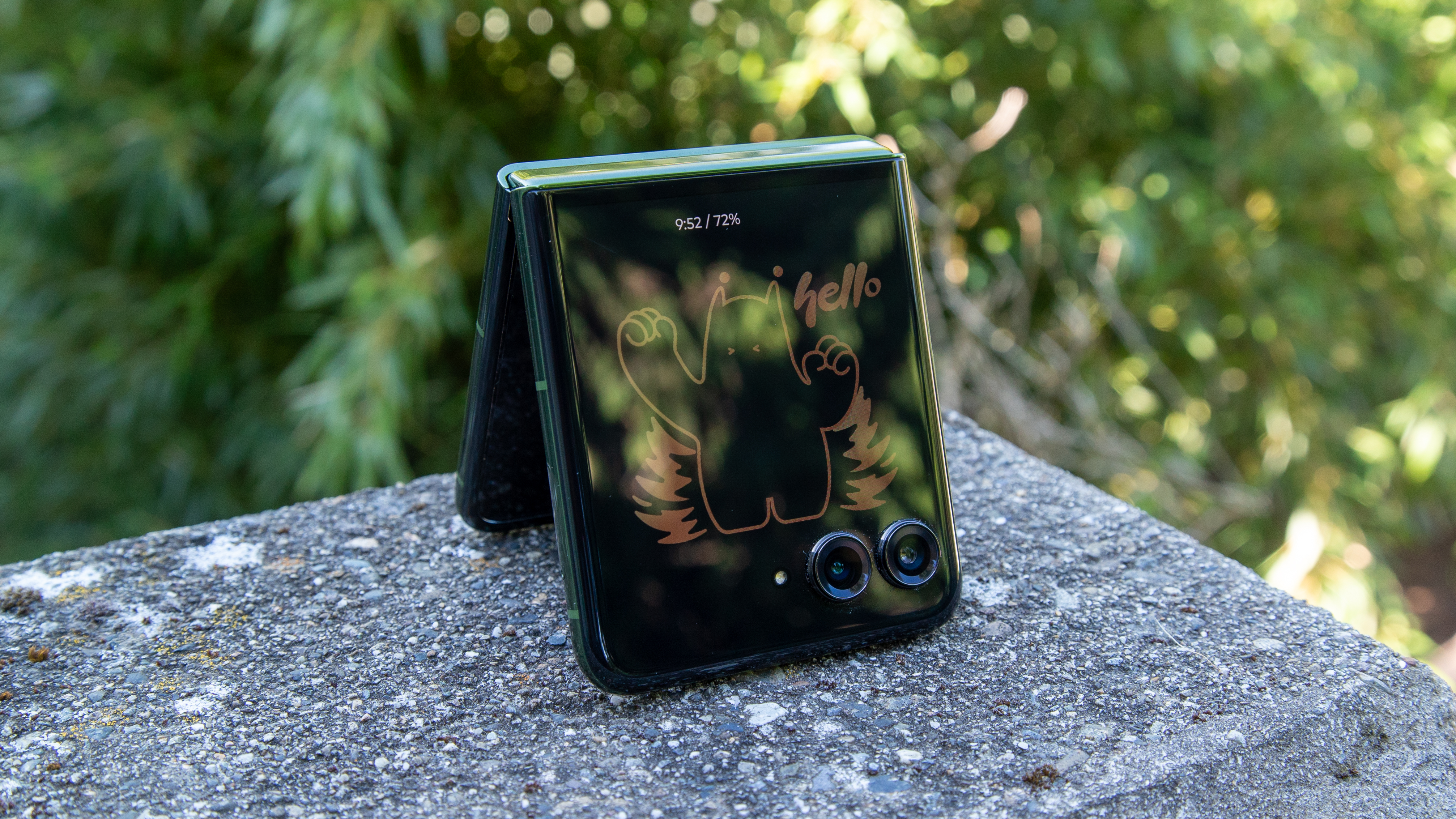
With Desk display, when the phone is open at an angle or set up like a tent, the display will act as a screensaver of sorts. It will display a carousel of images, notification icons, battery level, time, and more, and you can use preset images or add your own to the carousel. It's not a terribly useful feature, but it's a nice addition nonetheless, and I like that Motorola is looking for ways to take advantage of the flip phone form factor.
Motorola Razr Plus 2024: Software
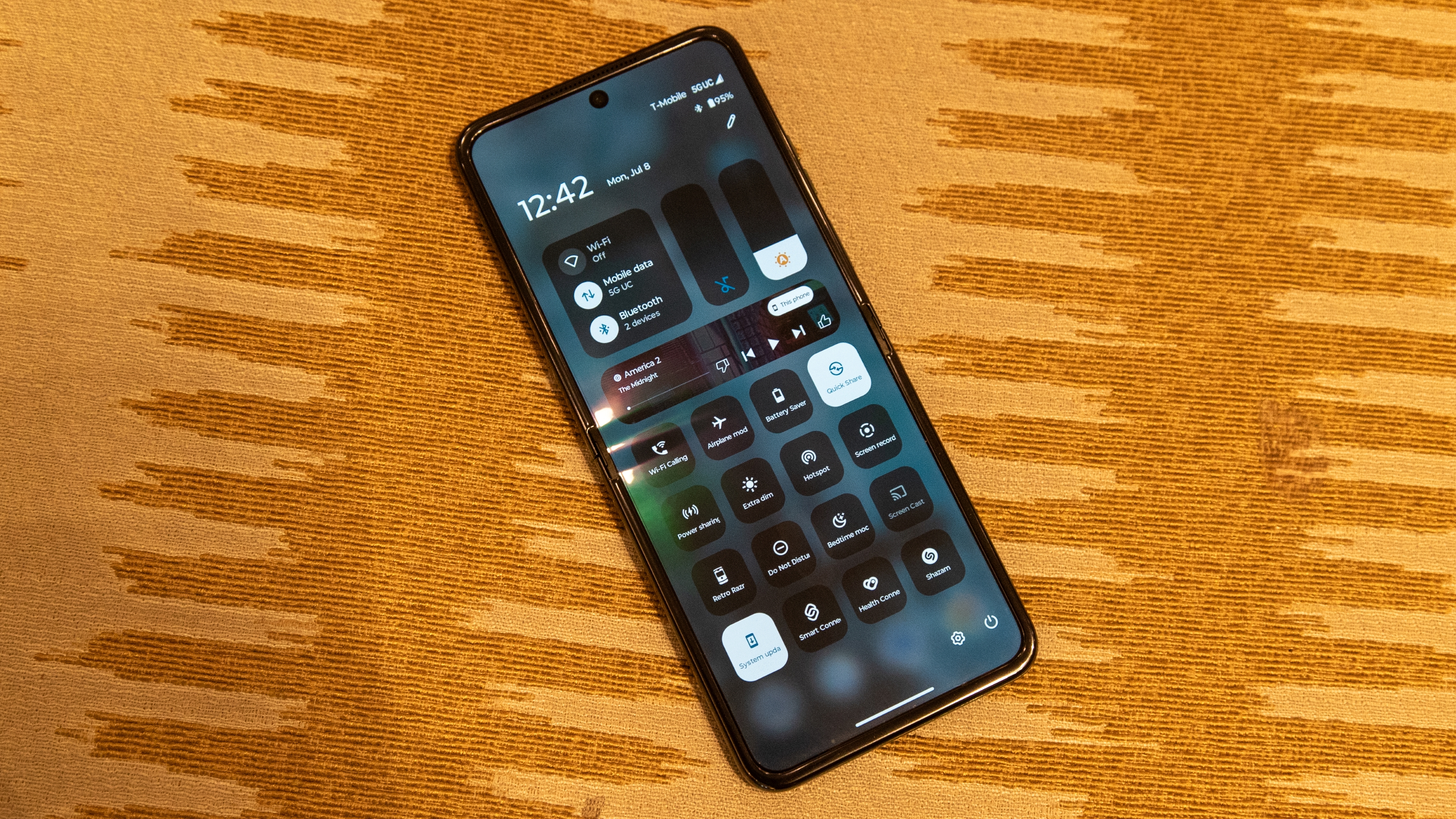
Software on the Motorola Razr Plus 2024 has been a bit of a mixed bag. On the one hand, I like the new Hello UX, as it feels like a welcome departure from the stock Android experience that Motorola has largely stuck with until now. It's not a huge overhaul, but there are some new UI aspects like the new Control Panel and Settings menu that are clearly different, and while some may be borrowed from other OEMs, I like the changes.
That said, Hello UX — which is based on Android 14 — should feel familiar for the most part, aside from the revamped Control Panel (you can always switch back to the stock quick settings/notification experience, as this is the default).
While I like the changes Motorola has made, there are moments when the software would freeze on me when switching from the main display to the cover screen, and both displays would appear black for a little bit before returning to normal. It happens every now and then, but not enough to really annoy me since it fixes itself fairly quickly. There are some other small software issues I've come across while using it, but I imagine these things can be fixed easily with an update. Still, it would be nice if it were a bit more polished.
Motorola's new Hello UX feels like a welcome departure from the stock Android experience, but there are some quirks.
Fortunately, Motorola retained its most useful features, like gestures to turn on the camera or flashlight and the side panel for opening your most used apps. The Razr Plus 2024 also supports Smart Connect, which works like a charm on my ASUS laptop and can be used to drag and drop content across devices, control multiple devices with one mouse and keyboard, or use a laptop or external display as a mobile desktop.
One new addition to the mix is Moto AI, which is being sprinkled throughout the software. Right now, you'll find it in a few experiences, such as the camera. For instance, with Style Sync, you can take or upload a photo, and the phone will create a wallpaper based on the image. The idea is to snap a photo of your current outfit so your phone can match.
Then there's Magic Canvas. It's an interesting take on the AI Wallpaper feature that you'll find on devices like the Pixel or some Galaxy phones with Android 14. Essentially, you type a prompt, and the phone will generate what you wrote. It's a fun feature, although the results are a bit too artsy for my liking. And while I previously found Samsung and Google's method of having users insert preselected words within prewritten prompts a bit limiting, I can't help but wish Motorola had gone with that instead of trying to create its own wallpaper feature from scratch.

Tragically, some of the more interesting Moto AI features are not yet available on the Razr Plus 2024, although they are expected to arrive soon. One feature takes your notifications and summarizes the most important information to catch you up on ongoing conversations you may have missed. There's also a Recall-like feature that remembers certain details for you based on your interactions by taking and saving snapshots (on-device) or by you telling Moto AI to "pay attention" so that it records and summarizes conversations for you.
Motorola says these features will arrive "in the coming months," but it would be nice if they were available at launch, as some of them seem legitimately interesting. But for now, new Razr Plus 2024 owners will just have to settle for three months of free Gemini Advanced.
Moto AI sounds like Motorola's answer to Gemini and Galaxy AI, but many features aren't here or feel half-baked.
Motorola's software promise for the Razr Plus 2024 hasn't changed, and the company will provide three OS upgrades and four years of software updates for the device. It's not bad, even if it's short of what we get from the Galaxy S24 series or Pixel 8. That said, Motorola doesn't have a great track record with software updates, and while the Razr Plus 2023 received regular bi-monthly updates, it only just started receiving Android 14 in the first week of July, nine months after it started rolling out on other devices.
Motorola Razr Plus 2024: Cameras

I'm happy to say that the Motorola Razr Plus 2024 has improved a lot in the imaging department. The 50MP primary sensor is a major step up from the 12MP sensor on last year's model, and Motorola's new AI-powered image engine proves to be quite capable.
Images from the Razr Plus 2024 are crisp and detailed, with a good amount of contrast and saturation without going overboard. It's almost a stark contrast to last year's Razr, which often produced flat and lifeless images, even if it leaned on truer-to-life color reproduction.
White balance is also much improved and the phone seems comfortable in most lighting conditions. Low-light and nighttime images aren't particularly strong, and you'll find some hits and misses, but I was able to capture some decent images of fireworks on the 4th of July.







There's no ultrawide camera, which might deter some of you, but I actually don't mind that Motorola switched it out for a 2x telephoto lens. The 50MP sensor actually produces images that are just as good as the primary camera and lets the phone retain a surprising amount of detail even at 8x zoom. Both lenses also have good natural bokeh, although it's slightly better with the portrait mode, which is to be expected.




As usual with the Razr Plus, you can use the cover screen to offer a preview of the image before you take it, which helps your subject position themselves. And of course, Motorola has also included some unique features with the camera like Adaptive Stabilization, which helps keep the video stable during intense movement, giving you an almost action-cam-like experience. There's also an easily accessible Action Cam button, which helps you capture fast-moving subjects and keep them in focus.
Another way Motorola is taking advantage of the flip phone form factor is with Auto Camcorder, which automatically starts recording as soon as you fold the phone 90-degrees, like an old-school camcorder. This mode also turns the bottom half into a touch pad of sorts, so you can use your thumb to easily zoom in and out while recording.
Motorola Razr Plus 2024: Battery life
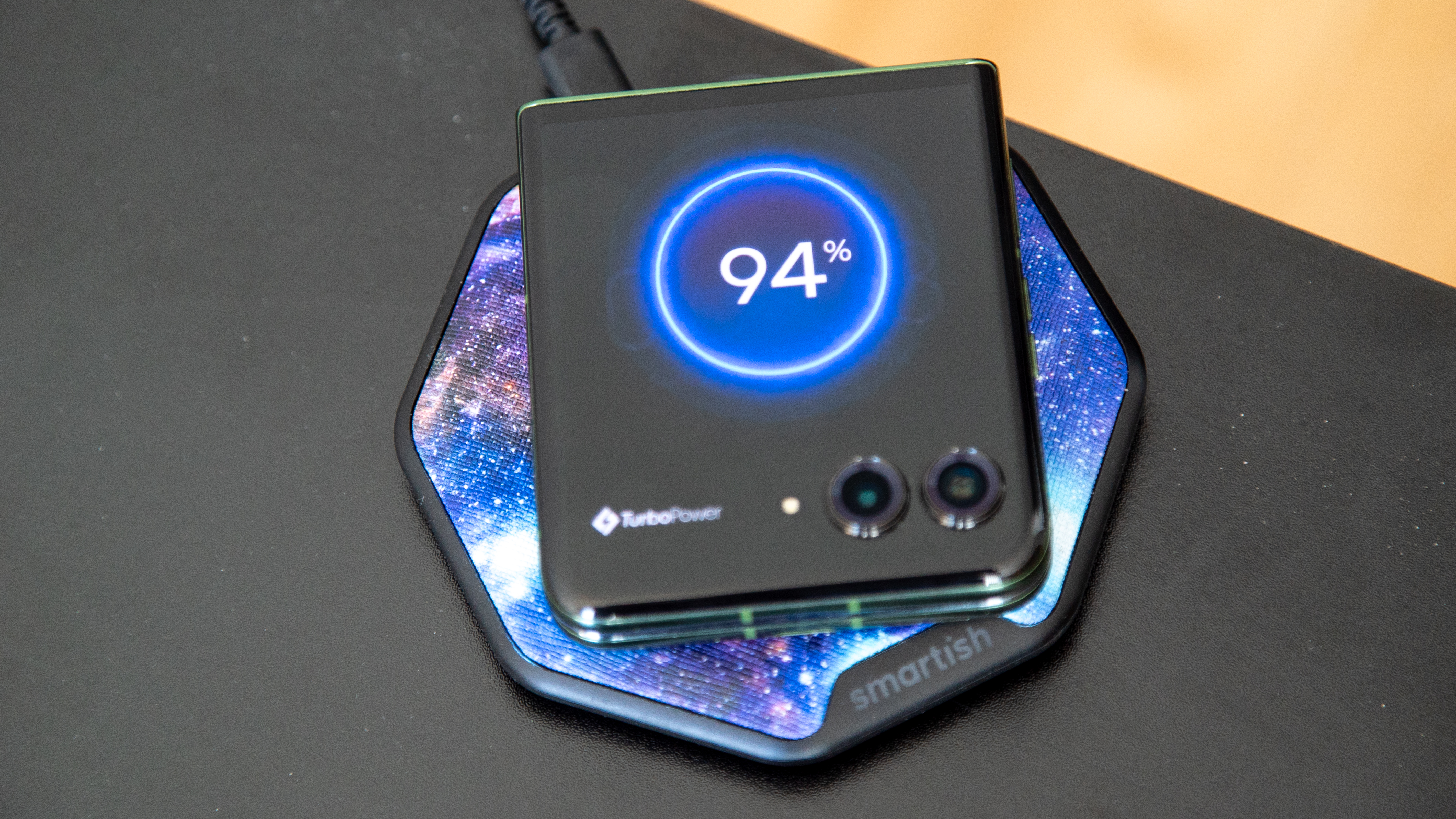
Battery life was a weak point of last year's Razr, but I'm happy to report that I'm actually quite pleased with the Razr Plus 2024 battery life. While the 2023 model could barely get me through half a day, the Razr Plus 2024 gets me through a good portion of the day—at least to the end of my work day after waking up at around 6 a.m.—on a single charge. You might be able to squeeze out a full day, depending on your use, but I'm admittedly a pretty heavy user. Still, it's nice to no longer have battery anxiety if I decide to leave my home with a 50% charge.
Meanwhile, charging speeds have also improved, thanks to 45W wired and 15W wireless charging support. You'll need your own 45W or higher charging adapter, but I'd suggest springing for a 100W charger.
Motorola Razr Plus 2024: Competition
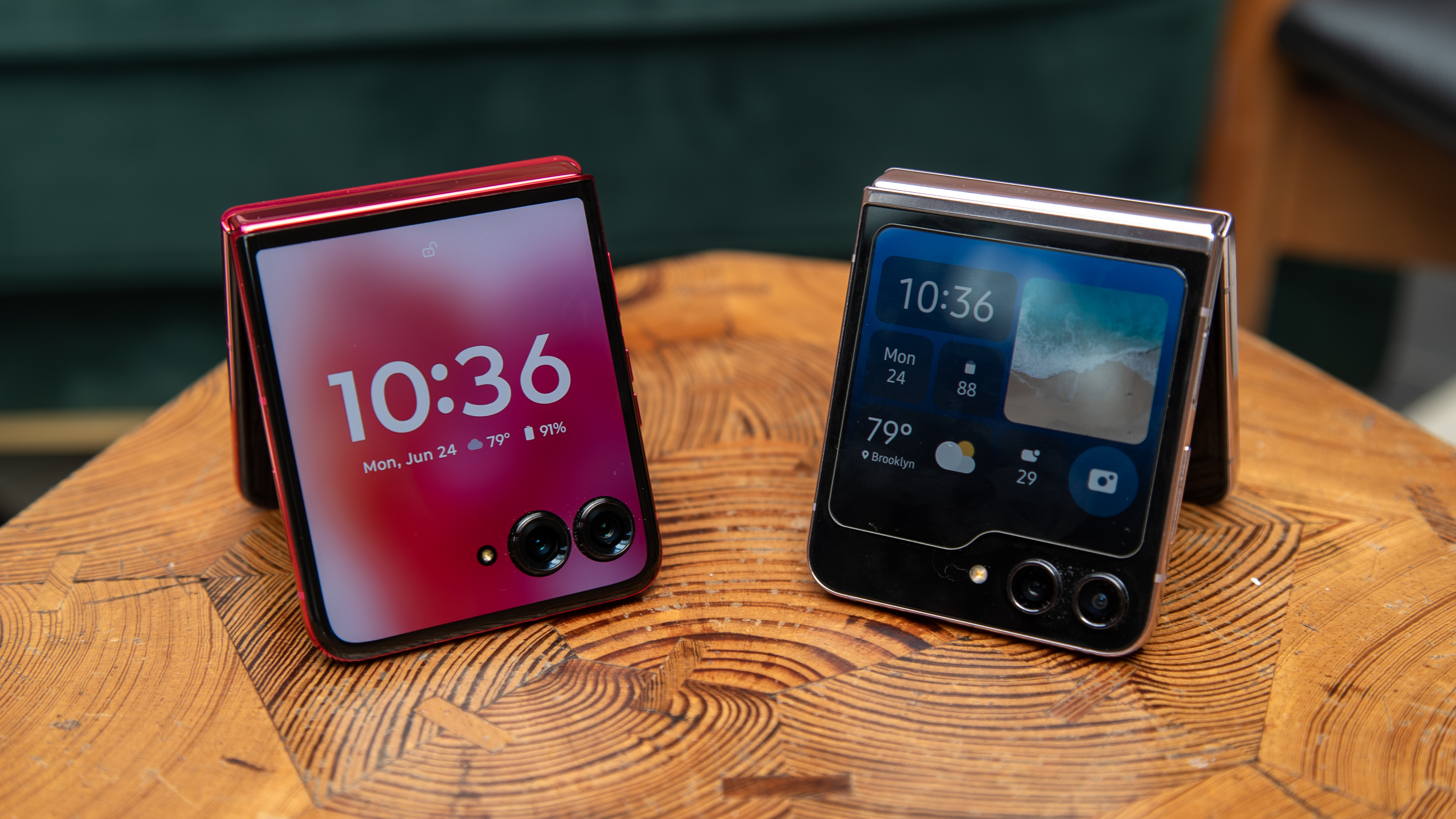
At the time of writing, the closest competitor to the Razr Plus 2024 is the Samsung Galaxy Z Flip 5. The phone features last year's Snapdragon 8 Gen 2 and a fairly large 3.4-inch cover screen. Camera quality is pretty good, and Samsung excels with software support, although the cover screen functionality is fairly limited compared to the Razr. The phone will also become old news once the Galaxy Z Flip 6 is launched, which will likely happen on July 10 during Galaxy Unpacked 2024.
Honor recently revealed its first flip phone, the Honor Magic V Flip, which also features a 4-inch cover screen. The unique software saves a small section of the cover screen for the time and notifications, while the remaining presents a vertical app display that supports more than 40 apps. Yet, while there are some impressive specs, the phone is powered by a much older Snapdragon 8 Plus Gen 1 and is only available in China.
If you want to go cheaper, the Nubia Flip 5G is a low-cost flip phone with a great design, a decent 50MP camera, and good performance. Of course, you miss out on the app experience with its smaller cover screen, the software isn't great, and there's no IP protection.
Motorola Razr Plus 2024: Should you buy it?

You should buy this if...
- You are looking for a modern flip-style phone.
- You want a phone with a good camera.
- You own last year's Razr Plus... it's really so much better.
You shouldn't buy this if...
- You want reliable software support and fast OS upgrades.
- You prefer to have an ultrawide camera over a telephoto sensor.
To say that I'm impressed with the Motorola Razr Plus 2024 is a bit of an understatement. Motorola actually listened and addressed the biggest shortcomings of last year's model, giving us better battery life, better cameras, better hardware, and even a better cover screen experience. The 2023 model already seemed ahead in many ways, setting a standard for the flip phone category that was once established by Samsung. Now, Motorola is using the Razr Plus 2024 to solidify itself in the foldable space with a flip phone that's almost perfect.
Of course, no phone is perfect, and the Razr Plus 2024 may not be enticing to everyone, especially after swapping the ultrawide camera for a telephoto lens. However, if that doesn't bother you, I feel like many of my biggest gripes can (and likely will) be addressed with some software updates.
Even with the Galaxy Z Flip 6 right behind it, I have a feeling the Razr Plus 2024 will be the best flip phone of the year.
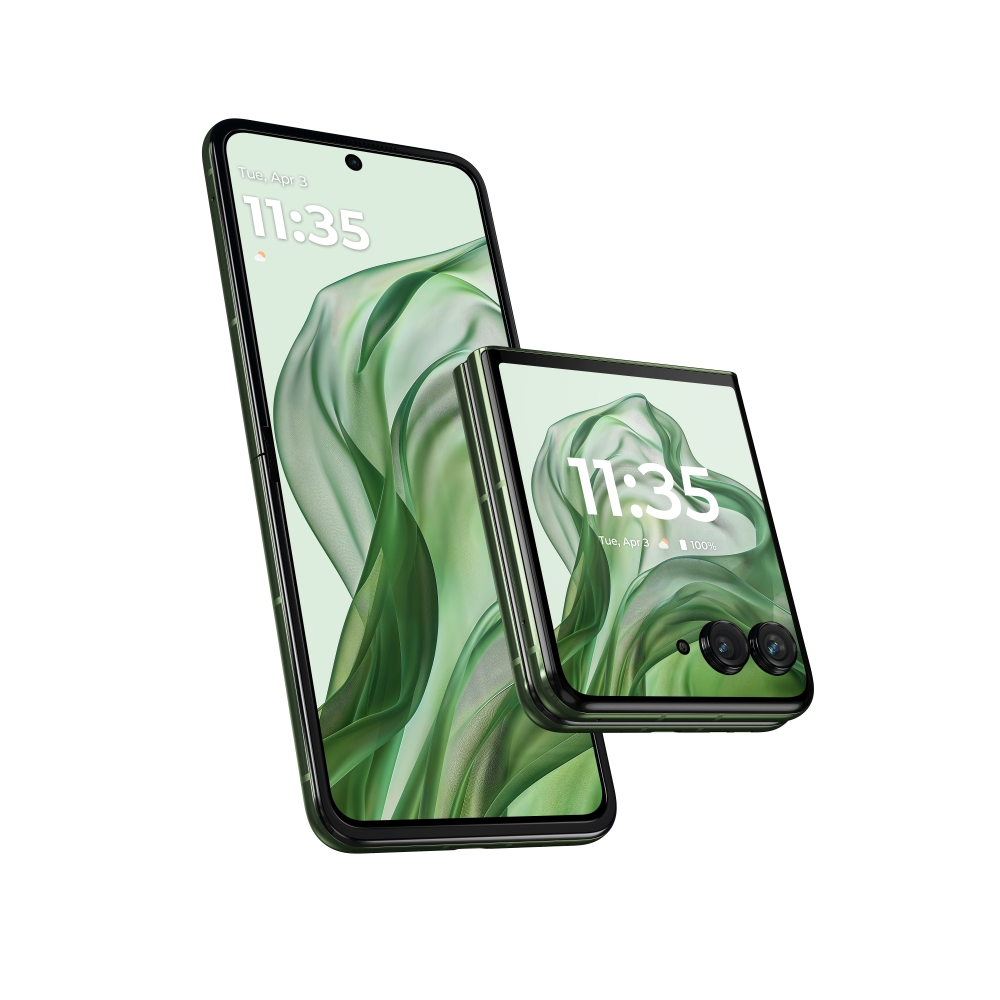
Razr sharp
The Motorola Razr Plus 2024 takes things up a notch with great performance, better battery life, and an even larger cover screen. It also brings improved cameras and a 2x telephoto sensor that gets you up close and personal when taking portrait shots. With Hello UX and Moto AI, this is the ultimate flip phone for creators.

Derrek is the managing editor of Android Central, helping to guide the site's editorial content and direction to reach and resonate with readers, old and new, who are just as passionate about tech as we are. He's been obsessed with mobile technology since he was 12, when he discovered the Nokia N90, and his love of flip phones and new form factors continues to this day. As a fitness enthusiast, he has always been curious about the intersection of tech and fitness. When he's not working, he's probably working out.
You must confirm your public display name before commenting
Please logout and then login again, you will then be prompted to enter your display name.
